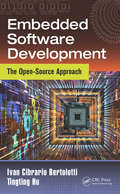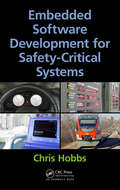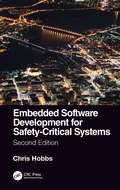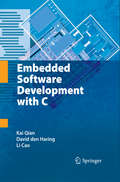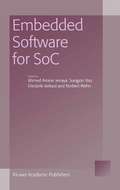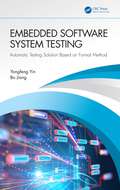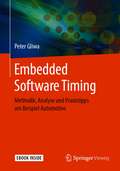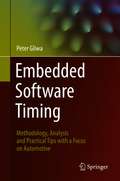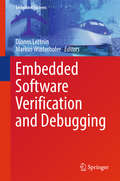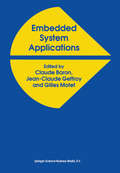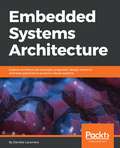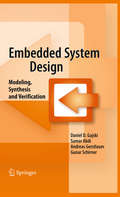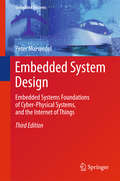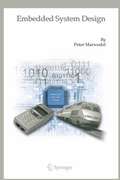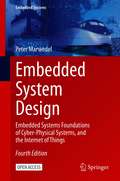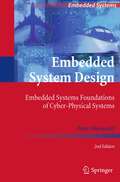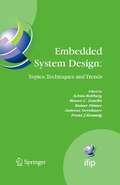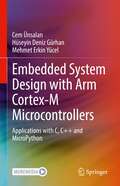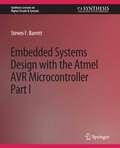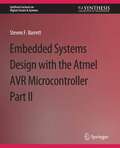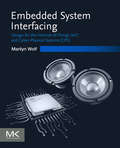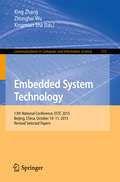- Table View
- List View
Embedded Software Development: The Open-Source Approach (Embedded Systems #4)
by Ivan Cibrario Bertolotti Tingting HuEmbedded Software Development: The Open-Source Approach delivers a practical introduction to embedded software development, with a focus on open-source components. This programmer-centric book is written in a way that enables even novice practitioners to grasp the development process as a whole. Incorporating real code fragments and explicit, real-world open-source operating system references (in particular, FreeRTOS) throughout, the text: Defines the role and purpose of embedded systems, describing their internal structure and interfacing with software development tools Examines the inner workings of the GNU compiler collection (GCC)-based software development system or, in other words, toolchain Presents software execution models that can be adopted profitably to model and express concurrency Addresses the basic nomenclature, models, and concepts related to task-based scheduling algorithms Shows how an open-source protocol stack can be integrated in an embedded system and interfaced with other software components Analyzes the main components of the FreeRTOS Application Programming Interface (API), detailing the implementation of key operating system concepts Discusses advanced topics such as formal verification, model checking, runtime checks, memory corruption, security, and dependability Embedded Software Development: The Open-Source Approach capitalizes on the authors’ extensive research on real-time operating systems and communications used in embedded applications, often carried out in strict cooperation with industry. Thus, the book serves as a springboard for further research.
Embedded Software Development for Safety-Critical Systems
by Chris HobbsSafety-critical devices, whether medical, automotive, or industrial, are increasingly dependent on the correct operation of sophisticated software. Many standards have appeared in the last decade on how such systems should be designed and built. Developers, who previously only had to know how to program devices for their industry, must now understand remarkably esoteric development practices and be prepared to justify their work to external auditors. Embedded Software Development for Safety-Critical Systems discusses the development of safety-critical systems under the following standards: IEC 61508; ISO 26262; EN 50128; and IEC 62304. It details the advantages and disadvantages of many architectural and design practices recommended in the standards, ranging from replication and diversification, through anomaly detection to the so-called "safety bag" systems.Reviewing the use of open-source components in safety-critical systems, this book has evolved from a course text used by QNX Software Systems for a training module on building embedded software for safety-critical devices, including medical devices, railway systems, industrial systems, and driver assistance devices in cars. Although the book describes open-source tools for the most part, it also provides enough information for you to seek out commercial vendors if that’s the route you decide to pursue. All of the techniques described in this book may be further explored through hundreds of learned articles. In order to provide you with a way in, the author supplies references he has found helpful as a working software developer. Most of these references are available to download for free.
Embedded Software Development for Safety-Critical Systems
by Chris HobbsSafety-critical devices, whether medical, automotive, or industrial, are increasingly dependent on the correct operation of sophisticated software. Many standards have appeared in the last decade on how such systems should be designed and built. Developers, who previously only had to know how to program devices for their industry, must now understand remarkably esoteric development practices and be prepared to justify their work to external auditors. Embedded Software Development for Safety-Critical Systems discusses the development of safety-critical systems under the following standards: IEC 61508; ISO 26262; EN 50128; and IEC 62304. It details the advantages and disadvantages of many architectural and design practices recommended in the standards, ranging from replication and diversification, through anomaly detection to the so-called "safety bag" systems.Reviewing the use of open-source components in safety-critical systems, this book has evolved from a course text used by QNX Software Systems for a training module on building embedded software for safety-critical devices, including medical devices, railway systems, industrial systems, and driver assistance devices in cars. Although the book describes open-source tools for the most part, it also provides enough information for you to seek out commercial vendors if that’s the route you decide to pursue. All of the techniques described in this book may be further explored through hundreds of learned articles. In order to provide you with a way in, the author supplies references he has found helpful as a working software developer. Most of these references are available to download for free.
Embedded Software Development for Safety-Critical Systems, Second Edition
by Chris HobbsThis is a book about the development of dependable, embedded software. It is for systems designers, implementers, and verifiers who are experienced in general embedded software development, but who are now facing the prospect of delivering a software-based system for a safety-critical application. It is aimed at those creating a product that must satisfy one or more of the international standards relating to safety-critical applications, including IEC 61508, ISO 26262, EN 50128, EN 50657, IEC 62304, or related standards. Of the first edition, Stephen Thomas, PE, Founder and Editor of FunctionalSafetyEngineer.com said, "I highly recommend Mr. Hobbs' book."
Embedded Software Development for Safety-Critical Systems, Second Edition
by Chris HobbsThis is a book about the development of dependable, embedded software. It is for systems designers, implementers, and verifiers who are experienced in general embedded software development, but who are now facing the prospect of delivering a software-based system for a safety-critical application. It is aimed at those creating a product that must satisfy one or more of the international standards relating to safety-critical applications, including IEC 61508, ISO 26262, EN 50128, EN 50657, IEC 62304, or related standards. Of the first edition, Stephen Thomas, PE, Founder and Editor of FunctionalSafetyEngineer.com said, "I highly recommend Mr. Hobbs' book."
Embedded Software Development with C
by Kai Qian David Den Haring Li CaoEmbedded Software Development With C offers both an effectual reference for professionals and researchers, and a valuable learning tool for students by laying the groundwork for a solid foundation in the hardware and software aspects of embedded systems development. Key features include a resource for the fundamentals of embedded systems design and development with an emphasis on software, an exploration of the 8051 microcontroller as it pertains to embedded systems, comprehensive tutorial materials for instructors to provide students with labs of varying lengths and levels of difficulty, and supporting website including all sample codes, software tools and links to additional online references.
Embedded Software for SoC
by Ahmed Amine Jerraya Norbert Wehn Diederik Verkest Sungjoo Sungjoo YooThis title covers all software-related aspects of SoC design, from embedded and application-domain specific operating systems to system architecture for future SoC. It will give embedded software designers invaluable insights into the constraints imposed by the use of embedded software in an SoC context.
Embedded Software System Testing: Automatic Testing Solution Based on Formal Method
by Yongfeng Yin Bo JiangThis book introduces embedded software engineering and management methods, proposing the relevant testing theory and techniques that promise the final realization of automated testing of embedded systems.The quality and reliability of embedded systems have become a great concern, faced with the rising demands for the complexity and scale of system hardware and software. The authors propose and expound on the testing theory and techniques of embedded software systems and relevant environment construction technologies, providing effective solutions for the automated testing of embedded systems. Through analyzing typical testing examples of the complex embedded software systems, the authors verify the effectiveness of the theories, technologies and methods proposed in the book.In combining the fundamental theory and technology and practical solutions, this book will appeal to researchers and students studying computer science, software engineering, and embedded systems, as well as professionals and practitioners engaged in the development, verification, and maintenance of embedded systems in the military and civilian fields.
Embedded Software System Testing: Automatic Testing Solution Based on Formal Method
by Yongfeng Yin Bo JiangThis book introduces embedded software engineering and management methods, proposing the relevant testing theory and techniques that promise the final realization of automated testing of embedded systems.The quality and reliability of embedded systems have become a great concern, faced with the rising demands for the complexity and scale of system hardware and software. The authors propose and expound on the testing theory and techniques of embedded software systems and relevant environment construction technologies, providing effective solutions for the automated testing of embedded systems. Through analyzing typical testing examples of the complex embedded software systems, the authors verify the effectiveness of the theories, technologies and methods proposed in the book.In combining the fundamental theory and technology and practical solutions, this book will appeal to researchers and students studying computer science, software engineering, and embedded systems, as well as professionals and practitioners engaged in the development, verification, and maintenance of embedded systems in the military and civilian fields.
Embedded Software Timing: Methodik, Analyse und Praxistipps am Beispiel Automotive
by Peter GliwaDie Zahl der Embedded Systeme, die uns im Alltag begegnen, wächst stetig. Gleichzeitig nimmt die Komplexität der Software immer weiter zu. In vielen Bereichen erhält Multicore Einzug, was die Komplexität nochmals erhöht.Ohne korrektes zeitliches Verhalten („Timing“) gibt es keine sichere und zuverlässige Embedded Software. Dieses Buch hilft gleichermaßen das Timing schon früh im Entwicklungsprozess zu berücksichtigen und akute Timingprobleme zu lösen. Auch der Aspekt der Laufzeitabsicherung kommt nicht zu kurz.Auch wenn die meisten Praxisbeispiele aus dem Automobilbereich kommen, ist der allergrößte Teile des Buches unmittelbar übertragbar auf andere Bereiche.
Embedded Software Timing: Methodology, Analysis and Practical Tips with a Focus on Automotive
by Peter GliwaWithout correct timing, there is no safe and reliable embedded software. This book shows how to consider timing early in the development process for embedded systems, how to solve acute timing problems, how to perform timing optimization, and how to address the aspect of timing verification.The book is organized in twelve chapters. The first three cover various basics of microprocessor technologies and the operating systems used therein. The next four chapters cover timing problems both in theory and practice, covering also various timing analysis techniques as well as special issues like multi- and many-core timing. Chapter 8 deals with aspects of timing optimization, followed by chapter 9 that highlights various methodological issues of the actual development process. Chapter 10 presents timing analysis in AUTOSAR in detail, while chapter 11 focuses on safety aspects and timing verification. Finally, chapter 12 provides an outlook on upcoming and future developments in software timing. The number of embedded systems that we encounter in everyday life is growing steadily. At the same time, the complexity of the software is constantly increasing. This book is mainly written for software developers and project leaders in industry. It is enriched by many practical examples mostly from the automotive domain, yet the vast majority of the book is relevant for any embedded software project. This way it is also well-suited as a textbook for academic courses with a strong practical emphasis, e.g. at applied sciences universities.Features and Benefits* Shows how to consider timing in the development process for embedded systems, how to solve timing problems, and how to address timing verification* Enriched by many practical examples mostly from the automotive domain* Mainly written for software developers and project leaders in industry
Embedded Software Verification and Debugging (Embedded Systems)
by Djones Lettnin Markus WinterholerThis book provides comprehensive coverage of verification and debugging techniques for embedded software, which is frequently used in safety critical applications (e.g., automotive), where failures are unacceptable. Since the verification of complex systems needs to encompass the verification of both hardware and embedded software modules, this book focuses on verification and debugging approaches for embedded software with hardware dependencies. Coverage includes the entire flow of design, verification and debugging of embedded software and all key approaches to debugging, dynamic, static, and hybrid verification. This book discusses the current, industrial embedded software verification flow, as well as emerging trends with focus on formal and hybrid verification and debugging approaches.
Embedded System Applications
by Jean-Claude Baron J. C. Geffroy Gilles MotetEmbedded systems encompass a variety of hardware and software components which perform specific functions in host systems, for example, satellites, washing machines, hand-held telephones and automobiles. Embedded systems have become increasingly digital with a non-digital periphery (analog power) and therefore, both hardware and software codesign are relevant. The vast majority of computers manufactured are used in such systems. They are called `embedded' to distinguish them from standard mainframes, workstations, and PCs. Athough the design of embedded systems has been used in industrial practice for decades, the systematic design of such systems has only recently gained increased attention. Advances in microelectronics have made possible applications that would have been impossible without an embedded system design. Embedded System Applications describes the latest techniques for embedded system design in a variety of applications. This also includes some of the latest software tools for embedded system design. Applications of embedded system design in avionics, satellites, radio astronomy, space and control systems are illustrated in separate chapters. Finally, the book contains chapters related to industrial best-practice in embedded system design. Embedded System Applications will be of interest to researchers and designers working in the design of embedded systems for industrial applications.
Embedded System Architecture: Explore Architectural Concepts, Pragmatic Design Patterns, And Best Practices To Produce Robust Systems
by Daniele LacameraEmbedded systems are self-contained units that have a dedicated purpose within a device. We come across a variety of applications of embedded systems in navigation tools, telecom applications, and networking equipment, to name just a few. This book will help you create your own parallel and distributed embedded systems.
Embedded System Design: Modeling, Synthesis and Verification
by Daniel D. Gajski Samar Abdi Andreas Gerstlauer Gunar SchirnerEmbedded System Design: Modeling, Synthesis and Verification introduces a model-based approach to system level design. It presents modeling techniques for both computation and communication at different levels of abstraction, such as specification, transaction level and cycle-accurate level. It discusses synthesis methods for system level architectures, embedded software and hardware components. Using these methods, designers can develop applications with high level models, which are automatically translatable to low level implementations. This book, furthermore, describes simulation-based and formal verification methods that are essential for achieving design confidence. The book concludes with an overview of existing tools along with a design case study outlining the practice of embedded system design. Specifically, this book addresses the following topics in detail: . System modeling at different abstraction levels . Model-based system design . Hardware/Software codesign . Software and Hardware component synthesis . System verification This book is for groups within the embedded system community: students in courses on embedded systems, embedded application developers, system designers and managers, CAD tool developers, design automation, and system engineering.
Embedded System Design: Embedded Systems Foundations of Cyber-Physical Systems, and the Internet of Things (Embedded Systems)
by Peter MarwedelA unique feature of this textbook is to provide a comprehensive introduction to the fundamental knowledge in embedded systems, with applications in cyber-physical systems and the Internet of things. It starts with an introduction to the field and a survey of specification models and languages for embedded and cyber-physical systems. It provides a brief overview of hardware devices used for such systems and presents the essentials of system software for embedded systems, including real-time operating systems. The author also discusses evaluation and validation techniques for embedded systems and provides an overview of techniques for mapping applications to execution platforms, including multi-core platforms. Embedded systems have to operate under tight constraints and, hence, the book also contains a selected set of optimization techniques, including software optimization techniques. The book closes with a brief survey on testing. This third edition has been updated and revised to reflect new trends and technologies, such as the importance of cyber-physical systems and the Internet of things, the evolution of single-core processors to multi-core processors, and the increased importance of energy efficiency and thermal issues.
Embedded System Design
by Peter MarwedelUntil the late eighties, information processing was associated with large mainframe computers and huge tape drives. During the nineties, this trend shifted towards information processing with personal computers, or PCs. The trend towards miniaturization continues. In the future, most of the information processing systems will be quite small and embedded into larger products such as transportation and fabrication equipment. Hence, these kinds of systems are called embedded systems. It is expected that the total market volume of embedded systems will be significantly larger than that of traditional information processing systems such as PCs and mainframes. Embedded systems share a number of common characteristics. For example, they must be dependable, efficient, meet real-time constraints and require customized user interfaces (instead of generic keyboard and mouse interfaces). Therefore, it makes sense to consider common principles of embedded system design. Embedded System Design starts with an introduction into the area and a survey of specification languages for embedded systems. A brief overview is provided of hardware devices used for embedded systems and also presents the essentials of software design for embedded systems. Real-time operating systems and real-time scheduling are covered briefly. Techniques for implementing embedded systems are also discussed, using hardware/software codesign. It closes with a survey on validation techniques. Embedded System Design can be used as a text book for courses on embedded systems and as a source which provides pointers to relevant material in the area for PhD students and teachers. The book assumes a basic knowledge of information processing hardware and software.
Embedded System Design: Embedded Systems Foundations of Cyber-Physical Systems, and the Internet of Things (Embedded Systems)
by Peter MarwedelA unique feature of this open access textbook is to provide a comprehensive introduction to the fundamental knowledge in embedded systems, with applications in cyber-physical systems and the Internet of things. It starts with an introduction to the field and a survey of specification models and languages for embedded and cyber-physical systems. It provides a brief overview of hardware devices used for such systems and presents the essentials of system software for embedded systems, including real-time operating systems. The author also discusses evaluation and validation techniques for embedded systems and provides an overview of techniques for mapping applications to execution platforms, including multi-core platforms. Embedded systems have to operate under tight constraints and, hence, the book also contains a selected set of optimization techniques, including software optimization techniques. The book closes with a brief survey on testing. This fourth edition has been updated and revised to reflect new trends and technologies, such as the importance of cyber-physical systems (CPS) and the Internet of things (IoT), the evolution of single-core processors to multi-core processors, and the increased importance of energy efficiency and thermal issues.
Embedded System Design: Embedded Systems Foundations of Cyber-Physical Systems (Embedded Systems)
by Peter MarwedelUntil the late 1980s, information processing was associated with large mainframe computers and huge tape drives. During the 1990s, this trend shifted toward information processing with personal computers, or PCs. The trend toward miniaturization continues and in the future the majority of information processing systems will be small mobile computers, many of which will be embedded into larger products and interfaced to the physical environment. Hence, these kinds of systems are called embedded systems. Embedded systems together with their physical environment are called cyber-physical systems. Examples include systems such as transportation and fabrication equipment. It is expected that the total market volume of embedded systems will be significantly larger than that of traditional information processing systems such as PCs and mainframes. Embedded systems share a number of common characteristics. For example, they must be dependable, efficient, meet real-time constraints and require customized user interfaces (instead of generic keyboard and mouse interfaces). Therefore, it makes sense to consider common principles of embedded system design.Embedded System Design starts with an introduction into the area and a survey of specification models and languages for embedded and cyber-physical systems. It provides a brief overview of hardware devices used for such systems and presents the essentials of system software for embedded systems, like real-time operating systems. The book also discusses evaluation and validation techniques for embedded systems. Furthermore, the book presents an overview of techniques for mapping applications to execution platforms. Due to the importance of resource efficiency, the book also contains a selected set of optimization techniques for embedded systems, including special compilation techniques. The book closes with a brief survey on testing.Embedded System Design can be used as a text book for courses on embedded systems and as a source which provides pointers to relevant material in the area for PhD students and teachers. It assumes a basic knowledge of information processing hardware and software. Courseware related to this book is available at http://ls12-www.cs.tu-dortmund.de/~marwedel.
Embedded System Design: IFIP TC10 Working Conference: International Embedded Systems Symposium (IESS), May 30 - June 1, 2007, Irvine (CA), USA (IFIP Advances in Information and Communication Technology #231)
by Achim Rettberg Mauro Zanella Rainer Domer Andreas Gerstlauer Franz RammigThis volume presents the technical program of the 2007 International Embedded Systems Symposium held in Irvine, California. It covers timely topics, techniques and trends in embedded system design, including design methodology, networks-on-chip, distributed and networked systems, and system verification. It places emphasis on automotive and medical applications and includes case studies and special aspects in embedded system design.
Embedded System Design with ARM Cortex-M Microcontrollers: Applications with C, C++ and MicroPython
by Cem Ünsalan Hüseyin Deniz Gürhan Mehmet Erkin YücelThis textbook introduces basic and advanced embedded system topics through Arm Cortex M microcontrollers, covering programmable microcontroller usage starting from basic to advanced concepts using the STMicroelectronics Discovery development board. Designed for use in upper-level undergraduate and graduate courses on microcontrollers, microprocessor systems, and embedded systems, the book explores fundamental and advanced topics, real-time operating systems via FreeRTOS and Mbed OS, and then offers a solid grounding in digital signal processing, digital control, and digital image processing concepts — with emphasis placed on the usage of a microcontroller for these advanced topics. The book uses C language, “the” programming language for microcontrollers, C++ language, and MicroPython, which allows Python language usage on a microcontroller. Sample codes and course slides are available for readers and instructors, and a solutions manual is available to instructors. The book will also be an ideal reference for practicing engineers and electronics hobbyists who wish to become familiar with basic and advanced microcontroller concepts.
Embedded System Design with the Atmel AVR Microcontroller I (Synthesis Lectures on Digital Circuits & Systems)
by Steven BarrettThis textbook provides practicing scientists and engineers an advanced treatment of the Atmel AVR microcontroller. This book is intended as a follow-on to a previously published book, titled Atmel AVR Microcontroller Primer: Programming and Interfacing. Some of the content from this earlier text is retained for completeness. This book will emphasize advanced programming and interfacing skills. We focus on system level design consisting of several interacting microcontroller subsystems. The first chapter discusses the system design process. Our approach is to provide the skills to quickly get up to speed to operate the internationally popular Atmel AVR microcontroller line by developing systems level design skills. We use the Atmel ATmega164 as a representative sample of the AVR line. The knowledge you gain on this microcontroller can be easily translated to every other microcontroller in the AVR line. In succeeding chapters, we cover the main subsystems aboard the microcontroller, providing a short theory section followed by a description of the related microcontroller subsystem with accompanying software for the subsystem. We then provide advanced examples exercising some of the features discussed. In all examples, we use the C programming language. The code provided can be readily adapted to the wide variety of compilers available for the Atmel AVR microcontroller line. We also include a chapter describing how to interface the microcontroller to a wide variety of input and output devices. The book concludes with several detailed system level design examples employing the Atmel AVR microcontroller. Table of Contents: Embedded Systems Design / Atmel AVR Architecture Overview / Serial Communication Subsystem / Analog to Digital Conversion (ADC) / Interrupt Subsystem / Timing Subsystem / Atmel AVR Operating Parameters and Interfacing / System Level Design
Embedded System Design with the Atmel AVR Microcontroller II (Synthesis Lectures on Digital Circuits & Systems)
by Steven BarrettThis textbook provides practicing scientists and engineers an advanced treatment of the Atmel AVR microcontroller. This book is intended as a follow-on to a previously published book, titled Atmel AVR Microcontroller Primer: Programming and Interfacing. Some of the content from this earlier text is retained for completeness. This book will emphasize advanced programming and interfacing skills. We focus on system level design consisting of several interacting microcontroller subsystems. The first chapter discusses the system design process. Our approach is to provide the skills to quickly get up to speed to operate the internationally popular Atmel AVR microcontroller line by developing systems level design skills. We use the Atmel ATmega164 as a representative sample of the AVR line. The knowledge you gain on this microcontroller can be easily translated to every other microcontroller in the AVR line. In succeeding chapters, we cover the main subsystems aboard the microcontroller, providing a short theory section followed by a description of the related microcontroller subsystem with accompanying software for the subsystem. We then provide advanced examples exercising some of the features discussed. In all examples, we use the C programming language. The code provided can be readily adapted to the wide variety of compilers available for the Atmel AVR microcontroller line. We also include a chapter describing how to interface the microcontroller to a wide variety of input and output devices. The book concludes with several detailed system level design examples employing the Atmel AVR microcontroller. Table of Contents: Embedded Systems Design / Atmel AVR Architecture Overview / Serial Communication Subsystem / Analog to Digital Conversion (ADC) / Interrupt Subsystem / Timing Subsystem / Atmel AVR Operating Parameters and Interfacing / System Level Design
Embedded System Interfacing: Design for the Internet-of-Things (IoT) and Cyber-Physical Systems (CPS)
by Marilyn WolfEmbedded System Interfacing: Design for the Internet-of-Things (IoT) and Cyber-Physical Systems (CPS) takes a comprehensive approach to the interface between embedded systems and software. It provides the principles needed to understand how digital and analog interfaces work and how to design new interfaces for specific applications. The presentation is self-contained and practical, with discussions based on real-world components. Design examples are used throughout the book to illustrate important concepts. This book is a complement to the author's Computers as Components, now in its fourth edition, which concentrates on software running on the CPU, while Embedded System Interfacing explains the hardware surrounding the CPU.Provides a comprehensive background in embedded system interfacing techniquesIncludes design examples to illustrate important concepts and serve as the basis for new designsDiscusses well-known, widely available hardware components and computer-aided design tools
Embedded System Technology: 13th National Conference, ESTC 2015, Beijing, China, October 10-11, 2015, Revised Selected Papers (Communications in Computer and Information Science #572)
by Xing Zhang Zhonghai Wu Xingmian ShaThis book constitutes the refereed proceedings of the 13th National Conference on Embedded System Technology, ESTC 2015, held in Beijing, China, in October 2015. The 18 revised full papers presented were carefully reviewed and selected from 63 papers. The topics cover a broad range of fields focusing on research about embedded system technologies, such as smart hardware, system and network, applications and algorithm.
